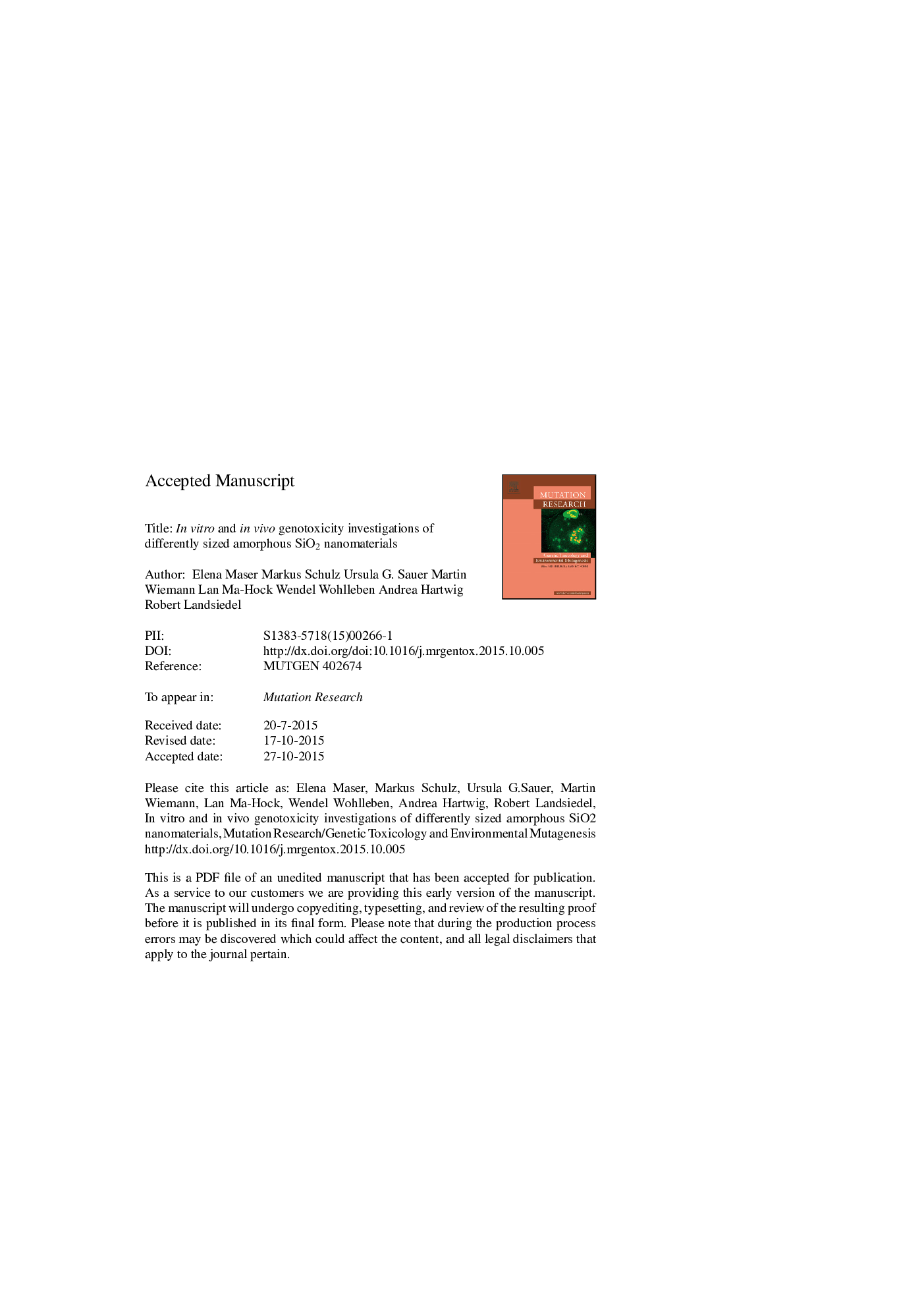| Article ID | Journal | Published Year | Pages | File Type |
|---|---|---|---|---|
| 8456307 | Mutation Research/Genetic Toxicology and Environmental Mutagenesis | 2015 | 64 Pages |
Abstract
In vitro and in vivo genotoxic effects of differently sized amorphous SiO2 nanomaterials were investigated. In the alkaline Comet assay (with V79 cells), non-cytotoxic concentrations of 300 and 100-300 μg/mL 15 nm-SiO2 and 55 nm-SiO2, respectively, relevant (at least 2-fold relative to the negative control) DNA damage. In the Alkaline unwinding assay (with V79 cells), only 15 nm-SiO2 significantly increased DNA strand breaks (and only at 100 μg/mL), whereas neither nanomaterial (up to 300 μg/mL) increased Fpg (Formamidopyrimidine DNA glycosylase)-sensitive sites reflecting oxidative DNA base modifications. In the Comet assay using rat precision-cut lung slices, 15 nm-SiO2 and 55 nm-SiO2 induced significant DNA damage at â¥100 μg/mL. In the Alkaline unwinding assay (with A549 cells), 30 nm-SiO2 and 55 nm-SiO2 (with larger primary particle size (PPS)) induced significant increases in DNA strand breaks at â¥50 μg/mL, whereas 9 nm-SiO2 and 15 nm-SiO2 (with smaller PPS) induced significant DNA damage at higher concentrations. These two amorphous SiO2 also increased Fpg-sensitive sites (significant at 100 μg/mL). In vivo, within 3 days after single intratracheal instillation of 360 μg, neither 15 nm-SiO2 nor 55 nm-SiO2 caused genotoxic effects in the rat lung or in the bone marrow. However, pulmonary inflammation was observed in both test groups with findings being more pronounced upon treatment with 15 nm-SiO2 than with 55 nm-SiO2. Taken together, the study shows that colloidal amorphous SiO2 with different particle sizes may induce genotoxic effects in lung cells in vitro at comparatively high concentrations. However, the same materials elicited no genotoxic effects in the rat lung even though pronounced pulmonary inflammation evolved. This may be explained by the fact that a considerably lower dose reached the target cells in vivo than in vitro. Additionally, the different time points of investigation may provide more time for DNA damage repair after instillation.
Keywords
FCScolony forming abilityJaCVAMIn vivo Comet assayIn vivo micronucleus testMNTCphSTIsHprtFPGOECDHBSSEMSNCEPCEMWCNTDMEMDLSESRPBSCFAAUCDulbecco’s modified Eagle mediumAANPpsROSanalytical ultracentrifugationMicronucleus testethyl methanesulfonatepolychromatic erythrocytesnormochromatic erythrocytesstandard deviationPrimary particle sizeBALFPrecision-cut lung slicesIntratracheal instillationminimal essential mediumtest guidelineElectronic spin resonanceOrganization for Economic Co-operation and Developmentfetal calf serumCentrophenoxineSIMSsecondary ion mass spectrometryX-ray photoelectron spectroscopyXPSformamidopyrimidine DNA glycosylasePhosphate buffered salineMEMBronchoalveolar fluidHank’s balanced salt solutionMulti-walled carbon nanotubeNanomaterialhypoxanthine-guanine phosphoribosyltransferasebody weightXRDDynamic Light ScatteringPositive controlnegative controlReactive oxygen species
Related Topics
Life Sciences
Biochemistry, Genetics and Molecular Biology
Cancer Research
Authors
Elena Maser, Markus Schulz, Ursula G. Sauer, Martin Wiemann, Lan Ma-Hock, Wendel Wohlleben, Andrea Hartwig, Robert Landsiedel,
